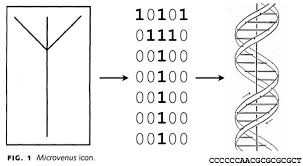Joe Davis' 'Microvenus' as molecular muse

Joe Davis’ Microvenus “infogene” encodes and inserts the superimposed letters “Y” and “I” (a primeval Germanic rune for both “female” and “life” itself) into a bacterium, converting a graphic emblem into phase values and then into a nucleotide sequence. The muse-worship that Robert Graves once located at the origins of Western verse tradition in The White Goddess can now be clinically literalized. Microvenus is a goddess reduced to bluntly iconic data and a molecular muse, a Venus emerging not from a fractal swirl of sea-foam but the Fibonacci spin of a gene-strand--mer is a measurement of DNA (a repeating molecular unit) as well as a Romance word for maternal “ocean.”
The four strokes that compose the Microvenus icon flout the Chinese proscription against four as the number for death. As an ironic fertility sigil, its “rune” is a talisman against species “ruin.” Working with binary code, Davis deploys “zero” and “one” (traditionally viewed, respectively if not always respectfully, as vulva and phallus) as a kind of primal poetic meter. Microvenus is a vaginal homage based on the fertile notch of a “v,” the monogram of “valley” and “vulva” alike. This sub-visible artworkis a diminished woman and an enduring genetrix, a boomeranging of sexist reduction and primeval role assignment, miniscule in its embodiment but vast in its implied trans-historical scale.
Microvenus is Davis’ signature project and a molecular message in a beaker. This particle is written into E. coli, a digestive bacterium most at home in our intestine and an extremophile able to survive the radical frigidity of outermost space. It is also a risk-taking genetic manipulation: Microvenus (which has by now reproduced itself into the billions) cannot be openly displayed in a Cabernet-serving art gallery but needs a positive-pressure biological containment facility to be exhibited.
“Copies” of Microvenus allowed to rampantly proliferate have been released into outer space in an unparalleled riot of “editions,” reproduced beyond a scale comparable to any other artwork. This is arguably the ultimate in audience expansions: by seeking to communicate with a potentially extraterrestrial readership, Davis spins Jack Spicer’s claim of channeling “poems by aliens” on its head. Davis’ self-replicating poem is a first edition that remains a first edition even as it sprouts sequels via self-cloning cell-division, remaining forever “first” chromosomally if not temporally.
Pressing on the Fertile (and dancing at the brink of the Fatal) has been Davis’ career-guiding impetus. He has recorded the vaginal contractions of ballerinas and translated their cadences into radio signals into deep outer space, in a project entitled Poetica Vaginal, converting reflexive actions into aleatory signals.He maintains a microscopic menagerie for his inquests into the deep hinterlands of interspecies fecundity, deploying a vocabulary not of words but of microbes. The varied bit-languages of living organisms form a lute made from molecular filaments in Davis’ bio-poetic hands.
Davis refers to trans-animating super-codes and a bio-molecular quest for selfhood, prodigiously multiplying cross-breeding hyphens around the most unnervingly central of biological questions. Davis’ Riddle of Life DNA from 1993 is coded with the imperative “know me and you will know yourself,” a message from a molecule to its human observer that entwines microcosmic gene and macrocosmic creature in a grammatic/genetic loop. His modular approach to conversion allows pixels, voxels, genes, and bit-code to interact, in a post-post-Babelian gathering of the tongues, a de-scattering of poetic and scientific languages. Still, he also refers to the challenging “slips” and “skips” that prevent too-direct genetic sequencing, comparable to idiomatic language’s refusal to translate across tongues.
Davis, in a project statement for 2000’s Ars Electronica,argues that bio-poetic “New Media” is a manipulation of the oldest media we know. The tautological cord of Gertrude Stein’s “A rose is a rose is a rose is a rose” is uncoiled in his counter-claim, “A rose is a Frankenstein”as he excavates the layers of breeding under apparently solid and stationary nouns and genes. He regards his experiments in molecular science and bioinformatics as artistic as well as empirical ventures, and has recently been working on projects like testing E. coli’s response to jazz (in an effort to bridge the melodic and metabolic) and growing a map of the Milky Way inside the whorled ear of a transgenic mouse. In these endeavors, the poetic and the genetic are placed in radical interface in order to enhance and undermine each other.
A p.s. to Genesis: notes on transgenic/bio-poetic art